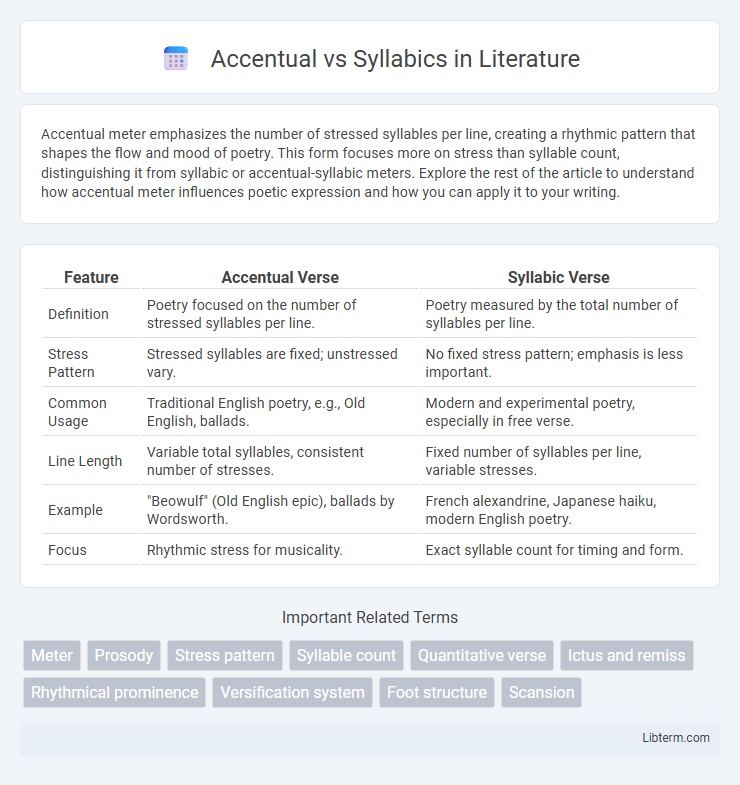Accentual meter emphasizes the number of stressed syllables per line, creating a rhythmic pattern that shapes the flow and mood of poetry. This form focuses more on stress than syllable count, distinguishing it from syllabic or accentual-syllabic meters. Explore the rest of the article to understand how accentual meter influences poetic expression and how you can apply it to your writing.
Table of Comparison
| Feature | Accentual Verse | Syllabic Verse |
|---|---|---|
| Definition | Poetry focused on the number of stressed syllables per line. | Poetry measured by the total number of syllables per line. |
| Stress Pattern | Stressed syllables are fixed; unstressed vary. | No fixed stress pattern; emphasis is less important. |
| Common Usage | Traditional English poetry, e.g., Old English, ballads. | Modern and experimental poetry, especially in free verse. |
| Line Length | Variable total syllables, consistent number of stresses. | Fixed number of syllables per line, variable stresses. |
| Example | "Beowulf" (Old English epic), ballads by Wordsworth. | French alexandrine, Japanese haiku, modern English poetry. |
| Focus | Rhythmic stress for musicality. | Exact syllable count for timing and form. |
Understanding Accentual and Syllabic Verse
Accentual verse emphasizes a fixed number of stressed syllables per line regardless of total syllables, creating rhythm through stress patterns, while syllabic verse relies on a fixed count of syllables per line without regard to stress. Understanding accentual verse involves recognizing how beat placement shapes the poem's flow, common in Old English and Germanic poetry. Syllabic verse, prominent in Japanese haiku and certain modern English poetry, prioritizes precise syllable counts to achieve a distinct rhythmic structure.
Historical Evolution of Poetic Forms
The historical evolution of poetic forms reveals a shift from accentual to syllabic structures, reflecting changes in linguistic patterns and oral traditions. Accentual verse, dominant in Old English poetry such as Beowulf, emphasizes stressed syllables regardless of total syllable count, aligning with Germanic languages' rhythmic patterns. Syllabic verse, which became prominent in Romance languages like French and later influenced English poetry, counts every syllable aiming for uniformity, mirroring the linguistic evolution and the abstraction of meter in medieval and modern poetry.
Defining Accentual Meter in Poetry
Accentual meter in poetry relies on the pattern of stressed syllables within a line, regardless of the total number of syllables present. This method emphasizes the count of strong beats or accents, making it common in Old English and Germanic verse where rhythm depends on stress rather than syllable quantity. Unlike syllabic meter, which counts all syllables evenly, accentual meter creates musicality through variable syllable counts paired with consistent stress patterns.
Exploring Syllabic Meter Characteristics
Syllabic meter in poetry is characterized by the precise count of syllables in each line, regardless of stress or accent, which distinguishes it from accentual meter focused on stressed beats. This meter is prevalent in languages like French and Japanese, where syllable count holds rhythmic importance over variations in stress. Exploring syllabic meter reveals its consistent rhythm through equal syllable distribution, emphasizing sound patterns and flow rather than stress-based emphasis.
Key Differences Between Accentual and Syllabic Verse
Accentual verse is based on a fixed number of stressed syllables per line regardless of total syllable count, emphasizing rhythmic stress patterns common in Old English poetry. Syllabic verse, in contrast, counts the total number of syllables per line without regard to stress, prevalent in languages like French and Japanese, where syllable quantity dictates the meter. The key difference lies in accentual verse prioritizing stress count, while syllabic verse focuses strictly on syllable count for poetic structure.
Notable Examples of Accentual Poetry
Accentual poetry, characterized by a fixed number of stressed syllables per line regardless of total syllable count, is exemplified in works like Geoffrey Chaucer's "The Canterbury Tales" and traditional Old English verse such as "Beowulf." These poems emphasize rhythm through stress patterns, creating a musical cadence that relies on accent rather than syllable count. The prominence of accentual meter in Anglo-Saxon poetry showcases its enduring influence on English poetic tradition.
Prominent Works in Syllabic Tradition
The syllabic tradition in poetry, characterized by counting syllables per line rather than stresses, includes prominent works like Marianne Moore's "Observations" and William Carlos Williams' "Spring and All." These poets emphasize syllable count to craft rhythm and structure, diverging from the more stress-focused accentual meters in Anglo-Saxon poetry. Their innovative use of syllabics reshaped modern poetry by prioritizing sound patterns and visual form over traditional stress accents.
Linguistic Influence on Poetic Structure
Accentual verse emphasizes stress patterns within lines, shaping rhythmic complexity through the deliberate placement of stressed syllables, which strongly influences the poem's natural speech cadence and emotional impact. Syllabic verse relies on a fixed number of syllables per line, independent of stress, promoting a consistent syllabic count that can create a more measured, even tempo conducive to languages with predictable syllable timing. Linguistic characteristics such as stress-timing in English favor accentual patterns, while syllable-timed languages like French or Japanese naturally lend themselves to syllabic poetic structures, demonstrating a profound link between linguistic properties and poetic form.
Choosing Between Accentual and Syllabic Forms
Choosing between accentual and syllabic forms hinges on the specific rhythmic emphasis and structural clarity desired in poetry or speech patterns. Accentual meter focuses on a fixed number of stressed syllables per line, enhancing emphasis and natural speech flow, while syllabic meter counts a fixed number of total syllables, providing precise rhythmic control regardless of stress. Understanding the linguistic context and artistic goals guides the selection of accentual or syllabic forms to achieve the intended auditory and aesthetic effect.
Modern Applications in Contemporary Poetry
Accentual verse emphasizes stressed syllables within lines, offering rhythmic flexibility, while syllabic verse counts fixed syllables, providing precise structural control. Contemporary poets employ accentual meter to mimic natural speech patterns, enhancing emotional resonance and musicality in free verse. Syllabic techniques are favored in experimental poetry, enabling innovative patterns and visual effects aligned with modern minimalism and digital poetry trends.
Accentual Infographic

 libterm.com
libterm.com